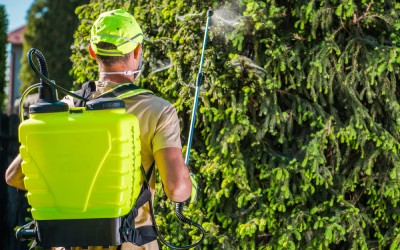It may seem like DIY pest control is a good way to save money, time, and unnecessary hassle: You don’t have to contact, pay or wait around for a professional exterminator. You can simply purchase some pesticide products at your local hardware store and you are ready to start your DIY adventure. However, DIY pest control carries significant downsides. If you’re considering this approach, you need to make sure you understand the downsides involved so you can take measures to minimize the risk to yourself, your family, and your home.
DIY Pest Control Risks
Do-it-yourself pest control carries many risks, from overusing pesticides to killing beneficial insects and wasting money on pest control products that don’t work. There are also risks from pesticides if you misuse them. Misuse of pesticides is the most common cause of illness and injury from pest control. You could also be injured by pests themselves, like getting bitten or stung while applying the product. There’s also a risk of electrical shock if electrical equipment, such as a bug zapper, is installed and used improperly. Pesticides need to be treated with caution and it is important to always follow the guidelines on labels, as well as, read all of the instructions, to minimize the risk of injury.
Pesticide Exposure
Exposure to pesticides can have a range of adverse health effects, even when used correctly. Improper use of pesticides may lead to chemicals leaking into water supplies, vegetable gardens, and possibly the air inside your home. Many DIY pest control chemicals have the potential to contaminate the ground and air around your home if not used properly. It’s important to read the instructions carefully and use the right amount of pesticide as directed.
For example, pesticides should be kept away from food and water supplies to avoid contaminating or poisoning people. When applying exterior treatments, often people forget that fish, frogs, and other animals may be living in or around their backyard ponds. If the product is applied too close to a water source, it can be harmful to all species that are using it. Another example, of misapplication that’s common with DIY pest control, is when homeowners forget to look for open windows while applying products on the exterior of the home, sometimes exposing those on the interior without knowing. Pesticides should also be stored in a place that’s out of reach of children and pets so they don’t come into contact with them. If spraying pesticides inside a home, it’s crucial to ensure there is adequate ventilation to allow the chemicals to dissipate.
Health and Safety Issues
There are several health and safety issues to be aware of when undertaking do-it-yourself pest control. For example, you should always wear protective clothing and gloves when handling pesticides and other chemicals. Pregnant women and young children should avoid entering areas where pesticides have been used. You should also wear protective equipment like a mask and eye goggles when you are working in areas where there might be pests or rodents. This will reduce the risk of getting bitten or stung. You should also clean up any mess that pests leave behind so they don’t attract more pests. Some pest droppings can contain harmful bacteria or roundworms that can make a human ill or cause death. Proper sanitation of areas should be done carefully and after sufficient research, if you’re unsure of the possible risks involved.
Negligence
There are situations where you can be held negligent or liable for your pest control practices. If you spray pesticide in a stuffy room or trap pests in a building without proper safety precautions, you could cause significant harm to other people creating civil and possibly even criminal liability. This is doubly true if you’re trying to eradicate a species of pest that’s protected by law.
Some products require you to vacate the area after application and you need to ensure that nobody would come in contact with that product for the proper amount of time.
Conclusion
While DIY pest control could save you money and time, it also comes with considerable risk. If you’re not careful, you could make things worse by harming yourself or others with pesticides or getting bitten or stung by the pests you’re trying to eliminate. Professional pest control specialists know how to find the pests that are invading, where they are coming from, how they got in, and how to stop them. Plus, they are trained to find the reasons why the pests are there and offer methods of preventing further infestations.
Pests need three things, food, water, and shelter. Your pest control professional will help to show you how your home is providing these to the pests and then how to stop it. With the integrated pest management approach, your professional pest technician will also be looking for ways to improve your landscaping and other factors around the home that will lead to less pest activity over time. When factoring all of this in, hiring a professional exterminator is not that expensive, not that much of a hassle, and likely to be more effective than a DIY approach.
Professional Pest Control
For nearly 15 years, Pest Defense Solutions has been providing safe, effective, and affordable pest control services in the Albuquerque NM area. Contact us today for a free quote!

